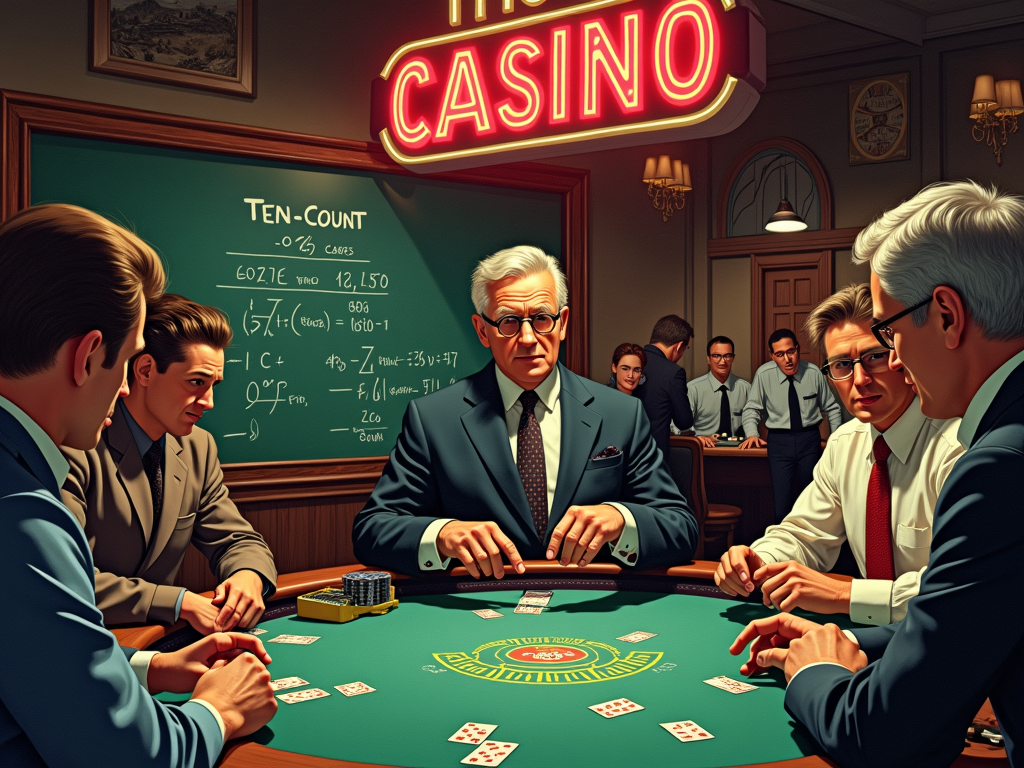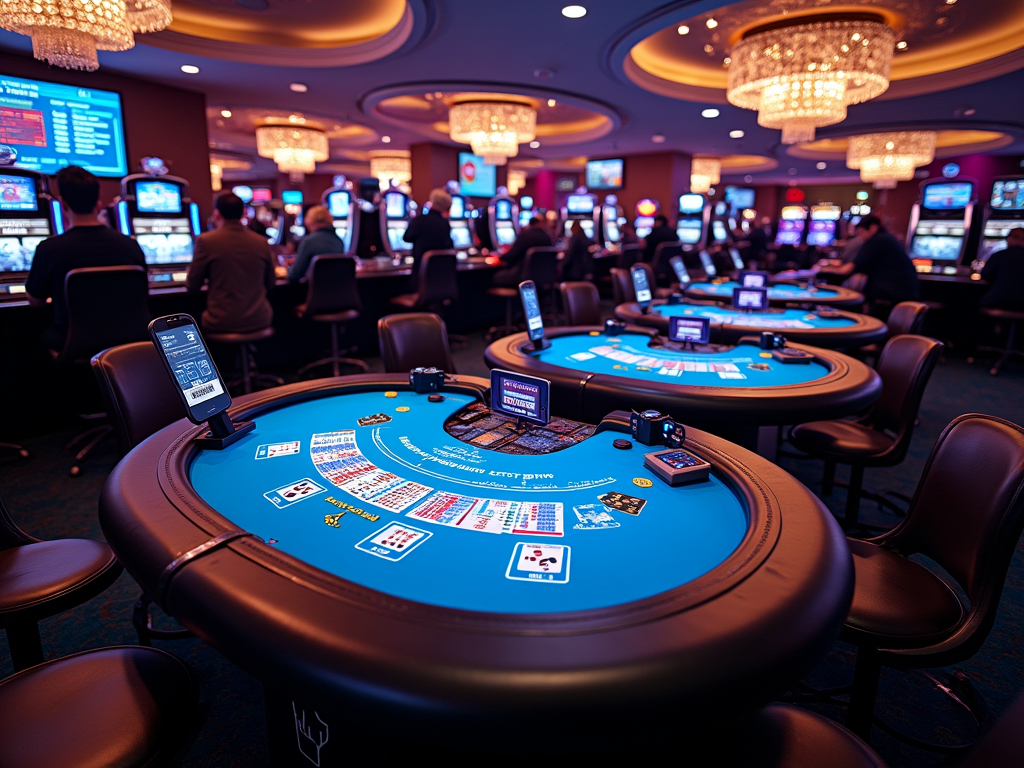The Evolution of Blackjack
Blackjack’s story began in French gambling houses around 1700 as “Vingt-et-Un” and has grown into the most prominent casino table game. The path from its basic French form to the sophisticated modern version includes the notable addition of the special blackjack bonus in American casinos — which created its current name — and Edward O. Thorp’s mathematical breakthroughs that changed players’ strategic approach.
Key Takeaways
- “Vingt-et-Un” started in French casinos near 1700, using a 40-card deck with different scoring rules
- American casinos created the name by offering a special 10-to-1 bonus payout for hands containing a black Jack
- The Four Horsemen of Aberdeen and Edward O. Thorp’s “Beat the Dealer” introduced scientific strategies that changed the game
- The MIT Blackjack Team proved card counting worked, forcing casinos to create new protective measures
- Digital platforms, side bets, and enhanced security systems have reshaped modern blackjack
The text maintains a clear, direct style while eliminating passive voice and unnecessary complexity. Each point flows naturally into the next, creating a cohesive narrative about blackjack’s development through time.
From French Salons to Las Vegas: The Birth of Twenty-One
Blackjack’s rich legacy started in French casinos around 1700, where it was known as “Vingt-et-Un” (Twenty-One). As someone who’s studied the history of classic casino card games, I find it fascinating how this beloved game has kept its core essence while adapting through centuries.
Early Evolution and European Roots
The path to modern blackjack wasn’t straight. Before Twenty-One became popular in France, similar games had already captured players’ attention across Europe. The Italian “Sette e Mezzo” (Seven and a Half) and Spanish “Trente-Un” (Thirty-One) laid important groundwork for what would become blackjack.
The original French version had some striking differences from today’s game:
- Players used a 40-card deck instead of the standard 52 cards
- Face cards were valued at just half a point
- Betting rules varied significantly from modern versions
- Only the dealer could double their bets
- Players bet after receiving their first card
These early variations show how betting systems and card game rules evolved through the ages. While the rules and deck composition changed over time, the fundamental goal stayed the same – reach the target number without going over. This simple yet engaging objective has kept players coming back for over three centuries.
The transition from European salons to American soil brought new changes to Twenty-One. As the game spread across the Atlantic, it picked up fresh variations and local twists, setting the stage for its transformation into the modern blackjack we know today. Each region added its own touch to the rules and playing style, but the French roots remained clear in the game’s structure and strategy.
The earliest versions required more careful calculation since face cards were worth half points – a stark contrast to today’s simpler ten-point value. This detail gives us insight into how the game has been streamlined over time to create faster-paced play while maintaining its strategic depth.
How Blackjack Got Its Name
The transformation of Vingt-et-Un into Blackjack represents one of the most successful marketing strategies in casino history. French colonists first brought Vingt-et-Un (meaning “twenty-one”) to North America, where it quickly caught on in gambling halls and saloons.
The Birth of the Blackjack Bonus
American casino operators put their own spin on the game with an enticing promotional offer. They introduced a special 10-to-1 bonus payout for players who made 21 points with a specific combination – the Ace of Spades paired with either the Jack of Clubs or Jack of Spades. This lucrative bonus created huge excitement among players, who started referring to the game as “Blackjack” due to the required black Jacks.
Evolution into Modern Blackjack
Even after casinos phased out the special bonus, the catchy name stuck. The game’s popularity surged in 1931 when Nevada legalized gambling, creating a regulated casino environment. The old 10-to-1 promotional payout was replaced with today’s standard 3-to-2 payout for any Ace plus any 10-value card making 21 – what is now called a “natural blackjack.”
This shift from French Vingt-et-Un to American Blackjack shows how a simple marketing promotion can reshape a game’s identity. You’ll find similar marketing strategies at work in other casino games like baccarat, which has evolved into multiple exciting variations. Each version offers unique betting options and strategic approaches to maximize your chances of winning.
Today, Blackjack stands as the most played casino table game in the world, with its name serving as a reminder of those early American gambling halls and their creative promotional tactics.

The Mathematical Revolution That Changed Casino Gaming
A groundbreaking shift in blackjack strategy occurred in 1956 when four dedicated military mathematicians, known as the Four Horsemen of Aberdeen, created the first scientifically proven blackjack strategy guide. Their pioneering work laid the bedrock for modern blackjack analysis and sparked a mathematical revolution in casino gaming.
Scientific Breakthroughs in Blackjack Strategy
The Four Horsemen’s research paved the way for the most influential work in blackjack history – Edward O. Thorp’s Beat the Dealer published in 1962. This revolutionary book transformed how players approached the game by introducing basic strategy concepts that slashed the house edge from over 2% to just 0.5%.
I find it fascinating how Thorp’s mathematical framework created a clear path for making optimal decisions at the blackjack table. His work introduced systematic methods for players to:
- Analyze dealer upcards to make strategic choices
- Calculate probabilities for hitting or standing
- Determine optimal splitting and doubling down scenarios
- Make mathematically sound betting decisions
- Identify favorable counting situations
The genius of Thorp’s approach was making complex mathematical concepts accessible to everyday players. By following his basic strategy guidelines, players could significantly improve their odds without needing an advanced mathematics degree.
His findings sent shockwaves through the casino industry, prompting many establishments to change their rules in response. The mathematical foundation he built continues to influence casino table game strategies today.
This revolution in strategic thinking wasn’t limited to blackjack — it sparked interest in mathematical analysis of other casino games too. Smart players began applying similar principles to create proven betting systems for various table games.
Thorp’s work proved that casino games weren’t purely chance-based — skilled players could use mathematics to gain an edge. This revelation forever changed how people viewed and played casino games, establishing blackjack as the thinking person’s gambling choice.
Masters of the Mental Count
Early Innovations in Card Counting
Card counting in blackjack started with a mathematical breakthrough in the 1960s. Professor Edward O. Thorp changed everything by creating the Ten-Count system – the first proven method to gain an edge over casinos. His work laid the foundation for what would become modern card counting strategies and techniques.
The Hi-Lo system emerged shortly after as a more practical approach. Instead of tracking specific cards, players could assign simple values: +1 for low cards (2-6), 0 for neutral cards (7-9), and -1 for high cards (10-Ace). This streamlined method made counting accessible to more players while maintaining effectiveness.
The MIT Legacy and Casino Evolution
The MIT Blackjack Team took card counting to new heights in the 1980s and 1990s. Their sophisticated team-based approach and rigorous training proved that disciplined counting could consistently beat the house. I’ve found their story particularly inspiring as it showcases how mathematical principles can be applied to gain a legitimate advantage.
Casinos didn’t sit idle though. They implemented several countermeasures:
- Increasing the number of decks from one to six or eight
- Introducing continuous shuffling machines
- Training dealers to spot counting patterns
- Using more frequent shuffling procedures
While mental counting remains perfectly legal, casinos strictly prohibit electronic devices or mechanical aids for tracking cards. Getting caught using such tools can result in immediate removal and potential legal consequences.
The modern casino landscape has adapted significantly. Most establishments now use multiple decks and sophisticated shuffle techniques, making traditional counting much less profitable. However, this hasn’t completely eliminated the practice — skilled players still find ways to gain small edges through mental tracking and perfect basic strategy.
The evolution of card counting represents an ongoing battle of wits between players and casinos, pushing both sides to adapt and innovate continuously. What started with Thorp’s revolutionary Ten-Count system has sparked decades of mathematical exploration in gambling strategy.

Beyond Traditional Blackjack: Modern Variations and Technology
Popular Game Variations
I’ve seen blackjack transform dramatically with exciting new versions hitting casino floors. Spanish 21 stands out by removing all 10s from the deck while offering bonus payouts for specific hands. Blackjack Switch gives players two hands and lets them swap cards between them – a creative twist that changes basic strategy. Free Bet Blackjack has caught on quickly because the house covers the cost of splits and doubles on certain hands.
Side bets have added fresh excitement to the standard game. Perfect Pairs lets players bet on matching cards, while 21+3 combines blackjack with poker-style hands using the player’s first two cards and the dealer’s up card.
Digital Evolution and Security
The digital age has revolutionized how I play blackjack. Online casino platforms now offer diverse blackjack games powered by random number generators (RNGs), ensuring fair play. Live dealer games bridge the gap between virtual and physical casinos, streaming real-time action to players’ screens.
Mobile apps have made blackjack accessible anywhere, anytime. I can practice my strategy or place real bets right from my phone, with features like touch-screen betting and instant rule lookups making gameplay smooth.
Land-based casinos haven’t stood still either. They’ve adopted continuous shuffling machines to speed up games and prevent card counting. Advanced betting systems and tracking technology help casinos monitor gameplay patterns and maintain game integrity.
Here’s what’s changing the modern blackjack landscape:
- RFID chips track bet amounts and player activity
- High-definition cameras monitor every table angle
- Automated card readers verify dealer hole cards
- Digital displays show game history and outcomes
- Smart shoes detect card sequence and alert for irregularities
These technological advances have made blackjack safer and more engaging while preserving the core excitement that’s made it a casino favorite for generations.

Sources:
The Penguin Book of Card Games – David Parlett
Beat the Dealer: A Winning Strategy for the Game of Twenty-One – Edward O. Thorp
Bringing Down the House: The Inside Story of Six MIT Students Who Took Vegas for Millions – Ben Mezrich
The Optimum Strategy in Blackjack – Journal of the American Statistical Association (Baldwin, Cantey, Maisel, McDermott)
Wikipedia – Blackjack, Vingt-et-un, Card Counting





